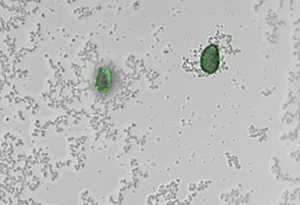Bacteria that make microplastics visible

Engineered microbes produce bioluminescence in the presence of microplastics, creating a living sensor seen here as a detectable green fluorescence signal, which is laid over a scanning electron microscope image.
September 3, 2025 – Microplastics are now found everywhere: in oceans, rivers, and even in drinking water. Measuring them is difficult and often expensive. Researchers have developed a method that uses bacteria to make microplastics visible.
The approach is based on a modified strain of Pseudomonas aeruginosa. This bacterium attaches to small plastic fragments and produces a green light signal. In this way, the presence of microplastics in a water sample becomes immediately clear. When combined with Raman spectroscopy, the method can also determine the type of polymer.
Laboratory tests showed that the bacterium responded to common plastics such as PET and polystyrene, but not to materials like glass or sand. The bacteria also remained active for several days under refrigeration, which is essential for practical use.
The system was tested on real water samples as well. It proved capable of detecting not only the presence of microplastics, but also the type of polymers involved. This makes it a practical tool for environmental monitoring, enabling local authorities to trace pollution more quickly and to determine which plastics are responsible.
This work was published September 2th in ACS Sensor titled ’Detection of Microplastics Pollution Using a Green Fluorescent Protein-Based Microbial Biosensor Coupled with Raman Spectroscopy, ACS Sensors (link via press release)









